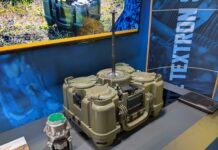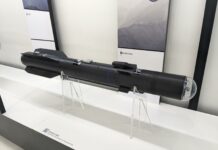The French and Swedish governments have signed a bilateral accord regarding the development of a Swedish version of the MBDA Akeron MP anti-tank missile, as well as the development of future variants of the missile, according to press releases by the Swedish Defence Materiel Administration (Försvarets materielverk – FMV) and Anglo-French missile house MBDA. The agreement was formally signed by the FMV and its French counterpart, the General Directorate for Armaments (Direction Générale de l’Armement – DGA), but also includes industry co-operation between MBDA and the Swedish defence contractor Saab.
The agreement is the conclusion to a project that started in July 2017, when the FMV issued a tender for the procurement of a new anti-tank missile system, to be known as the RBS 58, as a replacement for the in-service RBS 55 (‘RBS’ is the abbreviation for ‘Robotsystem’, which is the Swedish term for ‘guided weapon’ or ‘missile). RBS 55 is the Swedish designation for the US BGM-71 TOW anti-tank missile.
The tender concluded with the signing in July 2021 of a Letter of Intent (LoI) between the French and Swedish governments, again represented by the DGA and the FMV, to co-develop a new anti-tank missile for the Swedish armed forces based on the MBDA Akeron MP, previously known as the Missile Moyenne Portée, or Medium Range Missile’. This was originally developed as a replacement for the MILAN anti-tank missile in French service.
Following the LoI, the integration of the Akeron MP with a range of Swedish armoured vehicles, including the CV 90 infantry combat vehicle, and the firing of the Akeron MP from these vehicles, was successfully demonstrated in the autumn and winter of 2022.
A lightweight, multi-purpose missile, the Akeron MP has a weight of around 15 kg, including the launch tube, and a range in excess of 4,000 m. Its light weight and compact dimensions allows the Akeron MP to be deployed both from vehicles and by dismounted troops.

The missile uses a fire-and-forget guidance system, where the user acquires the target, locks the missile onto the target and fires. The missile’s infrared/optical seeker enables it to home in on the target autonomously, with no further input needed, thereby allowing the user to immediately leave the firing position. In addition, the Akeron MP is equipped with a fibre-optic cable link back to the launcher, giving it a so-called ‘man-in-the-loop’ mode, where the missile is launched before being locked onto a specific target. Images from the missile seeker are transmitted, via the fibre-optic cable, back to the user, who can then observe the target area, lock the missile onto a particular target, switch targets mid-flight or abort the fire mission. The user can even select a particular aimpoint on the chosen target. This also allows the missile to engage targets behind obstacles and, if engaging heavily armoured targets such as main battle tanks, to perform a ‘top attack’ flight profile, where the missile strikes the thinner top armour of the target.
Further increasing the multi-purpose nature of the missile is its scalable-effects tandem-charge warhead, which enables the missile to effectively engage a wide range of battlefield targets, including heavy and medium armour, bunkers and other structures, small naval vessels and infantry in the open.
Lastly, the missile uses a reduced-backblast launch system, giving it a reduced launch signature and allowing it to be fired from enclosed spaces, such as from inside buildings during urban combat.
No specific details have been released regarding the ultimate outcome of the agreement, such as overall cost, the number of missiles to be procured by Sweden, the specific modifications intended for the Akeron MP to adapt it for Swedish service, or the possibility of having the missile produced in Sweden by Saab.
Thomas Lauge Nielson

















